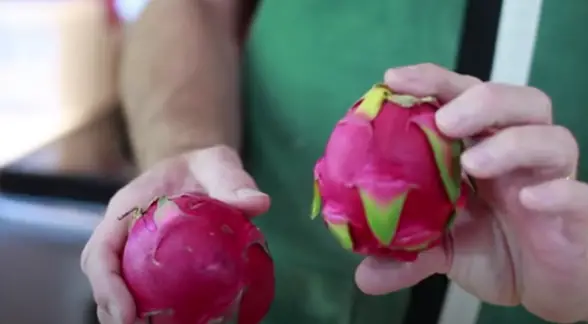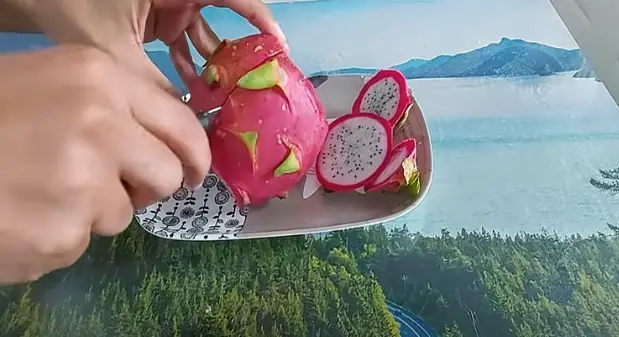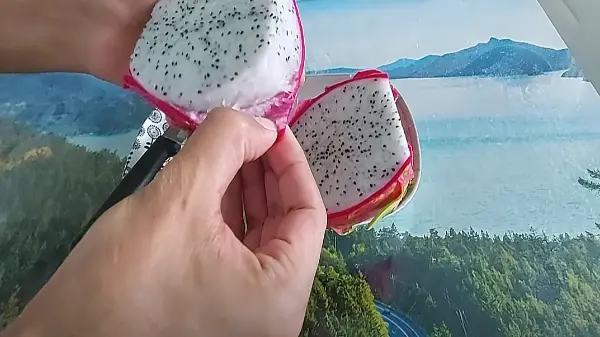Short answer: Cut off the stem, then slice the dragon fruit in half lengthwise. Use a spoon to scoop out the flesh or make additional slices in the flesh for easier removal.
Dragon fruit, or pitaya, is a stunning fruit, known for its vibrant exterior and subtly sweet, seed-studded interior. Hailing originally from Central America, it’s now enjoyed worldwide. It’s not just delicious but also packed with beneficial antioxidants, vitamin C, and fiber. Despite its exotic appearance, slicing a dragon fruit is a straightforward process that allows you to enjoy the fruit either by itself or as a unique addition to various dishes.
What Is Dragon Fruit?

Dragon fruit, also known as pitaya, is a tropical fruit known for its vibrant red skin and sweet, seed-speckled pulp. It’s native to Central America but is now grown all over the world.
What Does Dragon Fruit Taste Like?
Dragon fruit has a mild sweetness and is often described as a cross between a kiwi and a pear. Its texture is slightly crunchy due to the tiny black seeds within the flesh, which are edible. The fruit’s subtle taste and refreshing juiciness make it a delightful treat, especially when served chilled.
How To Choose Rip Dragon Fruit?

Observe the Skin: Make sure that the outside of the dragon fruit looks fresh and healthy. There should be no signs of mold, discoloration, or bruising.
Check the Stem: The stem at the bottom of the dragon fruit should be green. However, a green stem doesn’t always mean the fruit is healthy.
Inspect the Top: Look at the top of the fruit. If it’s starting to turn yellow, this may mean the fruit is starting to spoil.
Feel the Texture: The fruit should feel smooth and soft to the touch, but not mushy. If it feels mushy, it may be overripe and starting to break down.
How To Slice Dragon Fruit?
Method 1:
Step 1: Wash Your Dragon Fruit: Before handling and cutting, it’s important to properly clean the dragon fruit. This ensures that any dirt, pesticides, or other surface contaminants are removed.
Step 2: Wash with 1 Tbs Salt: Some prefer to wash their fruits with a bit of salt. Sprinkle a tablespoon of salt over the dragon fruit, then gently scrub and rinse with water. Salt acts as a gentle abrasive that can help clean the skin more effectively.

Step 3: Cut the Edges: With a sharp knife, trim off the top and bottom edges of the dragon fruit. This not only removes the potentially tough stem area but also provides a stable base for further slicing.

Step 4: Cut Dragon Fruit in Half Vertically: Stand the dragon fruit on one of the flat ends you’ve just created. Slice the fruit vertically (from top to bottom) into two equal halves.

Step 5: Peel It Off: After the dragon fruit is halved, you can easily peel off the skin. The skin is inedible but should come off smoothly.
Step 6: Slice in Small Cubes for Serving: Take each peeled half and cut it into slices. Then, make a perpendicular cut to form small, bite-sized cubes. This makes the dragon fruit easy to eat or add to salads, desserts, or smoothies.
Method 2:
Step 1: Select your dragon fruit: As mentioned, choose a fruit with bright, even-colored skin that has a little bit of give when gently squeezed but is not mushy.
Step 2: Cut the dragon fruit in half: Using a sharp knife, slice the dragon fruit vertically in half, from the stem to the bottom.
Step 3: Scoop out the flesh: Hold one half of the dragon fruit in your hand and use a spoon to gently scoop out the flesh, running the spoon along the edge of the skin to separate it from the flesh.
Step 4: Remove the flesh completely: Continue to scoop out the flesh until it’s entirely separated from the skin. Be careful not to break the skin if you plan to use it as a serving dish.
Step 5: Repeat with the other half: Do the same with the other half of the dragon fruit.
Step 6: Chop and serve: Once the flesh is removed, you can chop it into smaller pieces and use it in a variety of dishes such as fruit salads, smoothies, or fruit plates. You can also eat it on its own for a refreshing snack.
Slicing In Different Shapes
Spheres:
- You can use a melon baller to scoop out small, sphere-shaped pieces of dragon fruit.
- Cut the fruit in half, then scoop out the flesh in a circular motion.
Flat Rounds:
- Slice the dragon fruit in half, then lay the cut side down on the chopping board.
- Slice horizontally to create flat, round pieces of dragon fruit.
Wedges:
- Slice the dragon fruit in half, then slice each half into wedge-shaped pieces (like you would a watermelon).
- You can then easily remove the flesh from the skin of each wedge before eating.
Chunks:
- Cut the dragon fruit in half, then scoop out the flesh.
- Dice the flesh into small, bite-sized chunks.
- This is ideal for using dragon fruit in a fruit salad, a smoothie, or as a topping for desserts and breakfast bowls.
Health Benefits Of Dragon Fruit
- Reduces Risk of Diabetes: High fiber content in dragon fruit helps regulate blood sugar levels and prevent spikes, thereby benefiting people with diabetes.
- Reduces Risks of Cancer: The fruit’s anti-cancer properties and high vitamin C content can decrease the risk of colon cancer and enhance the immune system.
- Helps Boost Immunity: Dragon fruit contains significant levels of vitamin C, which strengthens your immune system and helps your body fight off various diseases.
- Good for Digestion: The oligosaccharides found in dragon fruit aid digestion by promoting the growth of healthy bacteria. The high fiber content also benefits the digestive system and can reduce the risk of cardiovascular disease and cancer.
- Good For the Heart: The reddish pulp of dragon fruit contains betalains which lower harmful cholesterol (LDL). Additionally, the small black seeds are rich in heart-healthy omega-3 and omega-9 fatty acids.
- Fights Ageing Skin: High antioxidant content helps combat acne, dry skin, and sunburn, while vitamin C contributes to more radiant skin.
- Good for Hair: Dragon fruit’s high vitamin content minimizes hair damage and enhances hair texture, providing smoother, shinier hair.
- Healthy Bones: Dragon fruit, with its 18% magnesium content, supports healthy and stronger bones, which can prevent injuries and relieve joint pain.
- Good For Eyes: Beta-carotene found in dragon fruit helps protect the eyes from conditions like macular degeneration and cataracts.
- Good During Pregnancy: Dragon fruit is rich in iron, folate, vitamin B, and calcium, all of which are essential nutrients during pregnancy for both the mother’s health and the baby’s development.
Nutritional Facts Of 100 Gram Dragon Fruit
| Nutrient | Amount/Value |
|---|---|
| Calories | 136 |
| Protein | 3 grams |
| Fat | 0 grams |
| Carbohydrates | 29 grams |
| Fiber | 7 grams |
| Sugar | 13 grams |
| Vitamin C | 9% of the Daily Value (DV) |
| Iron | 8% of the DV |
| Magnesium | 18% of the DV |
| Potassium | 8% of the DV |
How To Store The Dragon Fruit?
Step 1: Test the dragon fruit’s ripeness like you would with an avocado. Give it a squeeze to see if it yields a bit. If it’s hard, you can store it on your kitchen counter for a few days until it starts to soften up.
Step 2: Once the dragon fruit has ripened (when it gives a little bit to your squeeze), you can either eat it immediately or store it for a short amount of time.
Step 3: To store a ripe dragon fruit, wrap it in a plastic bag and place it in the refrigerator. This prevents it from drying out.
Step 4: Dragon fruit does not keep well once it’s cut. If you need to store cut dragon fruit, place it in an airtight container and consume it within 24 hours.
Step 5: If the dragon fruit starts turning brown or becomes mushy, it is no longer good to eat and should be discarded.
FAQs
What’s the difference between pitaya and dragon fruit?
Pitaya and dragon fruit are essentially the same things. “Pitaya” is the term often used in the fruit’s native regions (Central America), while “dragon fruit” is a name given due to the fruit’s unique appearance, resembling a dragon’s scales.
Can you eat dragon fruit seeds?
Yes, dragon fruit seeds are small, crunchy, and can be consumed along with the flesh. They contain nutrients such as lipids and proteins.
Can I cook or bake dragon fruit?
While dragon fruit is typically eaten fresh, it can be cooked or baked. However, it should be noted that heat may alter the texture and flavor of the fruit. It can be used in baking recipes, grilled, or even made into a sauce.
Does freezing my dragon fruit decrease its nutritional value?
Freezing doesn’t significantly reduce the nutritional value of dragon fruit, but some vitamins, like vitamin C, might degrade slightly. Frozen dragon fruit is excellent in smoothies, and it’s a great way to preserve the fruit for longer periods.
Can dragon fruit stain your clothes or skin?
The white or yellow flesh varieties of dragon fruit are not known for staining. However, the red flesh variety of dragon fruit could potentially cause some temporary discoloration to the skin or fabric, but it’s not typically a strong dye like beetroot.
Do you eat the skin of dragon fruit?
No, the skin of the dragon fruit is not typically eaten due to its tough texture and because it might contain harmful substances, like pesticides. The fruit is usually cut in half, and the flesh inside is scooped out to eat.
Conclusion
Dragon fruit offers a unique flavor profile and health benefits, making it a great addition to your diet. It’s easy to prepare once you know how: simply slice it in half, then either scoop out the flesh or make additional slices for smaller, bite-sized pieces. Remember, the skin is not for consumption. Enjoy this exotic fruit in smoothies, salads, or on its own for a nutritious snack.

John Hebdon is a food enthusiast, passionate chef, and author of various articles and blog posts related to food and cooking. With a deep love for all things culinary, John’s blog serves as a platform to share his extensive kitchen experiences with a broader audience.
In addition to his culinary expertise, John has a flair for writing and a natural ability to share his passion for food with others. His articles and blog posts are informative, engaging, and packed with practical tips for readers of all skill levels.
As a food enthusiast and writer, John is always on the lookout for new and exciting culinary experiences. Whether it’s trying out a new restaurant, experimenting with a new recipe, or simply sharing a favorite dish with friends and family, John is always eager to explore and share the world of food with others.






